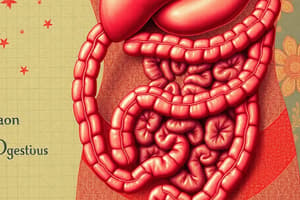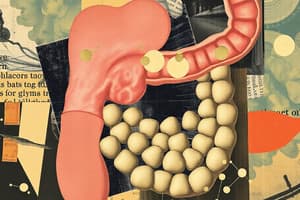Podcast
Questions and Answers
What is the process of breaking down nutrients into smaller molecules called?
What is the process of breaking down nutrients into smaller molecules called?
- Secretion
- Digestion (correct)
- Motility
- Absorption
Which of the following substances is released into the gastrointestinal tract to aid in digestion?
Which of the following substances is released into the gastrointestinal tract to aid in digestion?
- Feces and bacteria
- Electrolytes and smooth muscle cells
- HCL and water
- Bile and digestive enzymes (correct)
What is the term for the movement of nutrient content from the mouth to the anus?
What is the term for the movement of nutrient content from the mouth to the anus?
- Absorption
- Secretion
- Digestion
- Motility (correct)
What is the outermost layer of the digestive tract?
What is the outermost layer of the digestive tract?
What is the process by which the body removes waste products?
What is the process by which the body removes waste products?
What is the layer of the digestive tract that is in direct contact with the content in the lumen?
What is the layer of the digestive tract that is in direct contact with the content in the lumen?
What is the term for the uptake of nutrients into the bloodstream or lymph?
What is the term for the uptake of nutrients into the bloodstream or lymph?
What is the term for the waste material that leaves the digestive system at the end of the gastrointestinal tract?
What is the term for the waste material that leaves the digestive system at the end of the gastrointestinal tract?
What are the two types of neurons found in the ENS?
What are the two types of neurons found in the ENS?
What is a key function of the ENS in the digestive system?
What is a key function of the ENS in the digestive system?
Which of the following is NOT a function of the ENS in the digestive system?
Which of the following is NOT a function of the ENS in the digestive system?
What is the significance of the ENS being referred to as the "second brain"?
What is the significance of the ENS being referred to as the "second brain"?
What is the approximate percentage of the body's defense cells located in the intestines?
What is the approximate percentage of the body's defense cells located in the intestines?
What is the primary function of the two muscle layers that surround the ENS?
What is the primary function of the two muscle layers that surround the ENS?
What evidence supports the idea that the intestines are the "control center" of the digestive system?
What evidence supports the idea that the intestines are the "control center" of the digestive system?
What is the primary function of the hormone gastrin in the digestive system?
What is the primary function of the hormone gastrin in the digestive system?
Which of the following statements accurately describes the role of the vagus nerve in stomach function?
Which of the following statements accurately describes the role of the vagus nerve in stomach function?
What is the significance of the fact that "most of the processes in the gut work completely independently from the first brain"?
What is the significance of the fact that "most of the processes in the gut work completely independently from the first brain"?
Which hormone is responsible for stimulating the pancreas to release bicarbonate ions?
Which hormone is responsible for stimulating the pancreas to release bicarbonate ions?
Which of the following hormones is NOT produced by the small intestine?
Which of the following hormones is NOT produced by the small intestine?
What is the primary function of the hormone cholecystokinin (CCK)?
What is the primary function of the hormone cholecystokinin (CCK)?
What is the primary role of the hormone enterogastrin?
What is the primary role of the hormone enterogastrin?
How does the pH of the small intestine change after the arrival of acidic chyme from the stomach?
How does the pH of the small intestine change after the arrival of acidic chyme from the stomach?
Which of the following correctly describes the role of the endocrine system in the digestive process?
Which of the following correctly describes the role of the endocrine system in the digestive process?
What is the primary neurotransmitter that provides parasympathetic control in the intestines?
What is the primary neurotransmitter that provides parasympathetic control in the intestines?
Which type of nervous system is intertwined with gastrointestinal activities?
Which type of nervous system is intertwined with gastrointestinal activities?
Which part of the digestive system is under conscious control?
Which part of the digestive system is under conscious control?
What type of regulation allows the enteric nervous system to function independently?
What type of regulation allows the enteric nervous system to function independently?
Which nerve primarily supplies parasympathetic innervation to the intestines?
Which nerve primarily supplies parasympathetic innervation to the intestines?
What is the most important neurotransmitter of the sympathetic nervous system?
What is the most important neurotransmitter of the sympathetic nervous system?
Where do sympathetic nerves emerge from?
Where do sympathetic nerves emerge from?
What type of reflex allows the enteric nervous system to autonomously modulate its activity?
What type of reflex allows the enteric nervous system to autonomously modulate its activity?
What is the primary function of the ileocecal sphincter?
What is the primary function of the ileocecal sphincter?
Which of the following statements accurately describes the role of peristaltic contractions in the small intestine?
Which of the following statements accurately describes the role of peristaltic contractions in the small intestine?
What is the significance of the ileocecal valve's resistance to discharge?
What is the significance of the ileocecal valve's resistance to discharge?
Which part of the small intestine is responsible for the majority of nutrient absorption?
Which part of the small intestine is responsible for the majority of nutrient absorption?
Which of the following is NOT a function of the small intestine?
Which of the following is NOT a function of the small intestine?
What is the primary role of the villi and microvilli in the small intestine?
What is the primary role of the villi and microvilli in the small intestine?
How do smooth muscle contractions in the intestinal wall contribute to digestion and absorption?
How do smooth muscle contractions in the intestinal wall contribute to digestion and absorption?
Which of the following statements accurately describes the relationship between the ileocecal valve and the ileocecal sphincter?
Which of the following statements accurately describes the relationship between the ileocecal valve and the ileocecal sphincter?
Flashcards are hidden until you start studying
Study Notes
Digestion Process
- Digestion is achieved through the action of HCL (hydrochloric acid), bile, and various digestive enzymes released from the liver and exocrine glands into the gastrointestinal tract through the process of secretion.
- These substances break down molecules into smaller nutrients, which are then absorbed into the blood or lymph from the lumen of the gastrointestinal tract, a process called absorption.
Functions of the Digestive System
- Movement of food in the digestive tract
- Secretion of digestive secretions and digestion of food
- Absorption of digestive products, water, and various electrolytes
- Excretion of undigested, non-absorbable substances
- Regulation of these functions through local, nervous, and hormonal mechanisms
Layers of the Digestive Tract
- Mucosa: the innermost layer in direct contact with the content in the lumen
- Submucosa
- Muscularis externa
- Serosa
Enteric Nervous System (ENS)
- Coordinates with the autonomic nervous system and is intertwined with gastrointestinal activities
- Modulated by the sympathetic and parasympathetic nervous system
- Can work independently through intrinsic regulation and sensory reflexes
- Regulated by parasympathetic innervation (acetylcholine) and sympathetic innervation (noradrenaline)
Regulation of Gastrointestinal Activities
- Extrinsic regulation: modulated by the sympathetic and parasympathetic nervous system
- Intrinsic regulation: plexuses in various regions between the bowel layers
- ENS contains sensory, motor fibers, and neurons that provide integrity
"Second Brain"
- The latest research shows that the digestive system and spiritual processes are more closely interconnected than previously thought
- The intestines are the control center of the digestive system, analyzing gross values, controlling the delicate balance of sympathetic and parasympathetic nerves, stimulating hormones, and protective secretions, as well as nutrient absorption and defecation mechanism
- 70% of the defense cells are located in the gut, which works independently from the first brain
Hormones
- Endocrine: released into the circulation and can affect all parts of the organism
- Paracrine: affects cells in the immediate vicinity
- Neurocrine: synthesized by neurons and transmitted through the neuron to the cell it affects
- Gastrin, cholecystokinin, secretin, and enterogastrin hormones regulate the functions of the digestive system
Stomach
- The first place where food is collected after passing through the mouth
- The nervous system and endocrine system work together for the functioning of the stomach
- The vagus nerve and gastrin hormone regulate the functioning of the stomach
Small Intestine
- Last place of digestion
- Produces hormones that affect digestion, such as secretin, cholecystokinin, and enterogastrin
- Duodenum, jejunum, and ileum are the three parts of the small intestine, each with distinct functions
- Villi and microvilli increase the absorption surface in the small intestine
Studying That Suits You
Use AI to generate personalized quizzes and flashcards to suit your learning preferences.



